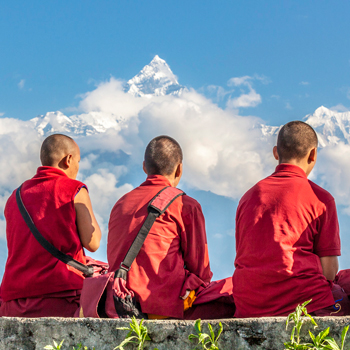Patan Durbar Square- Unmissable World Heritage Site in Nepal
- Monday January 2, 2023
- 0
Patan Durbar Square is the starting point for exploring the most interesting local tourist attractions, the royal palace, inner courtyards, temples, and pagodas. Patan durbar square is the abode of the ancient Royal Palace and its kings of Lalitpur. It has become an important cultural and religious center, where one of the most attractive museums in the city is located.
Like other Kathmandu valley’s durbar squares, you will also see many temples and pagodas in Patan Durbar Square – only everything is a bit smaller and cozier here than in the prominent neighborhood.
Patan Durbar Square is home to stupas from the Ashoka era; it bustles with activity, and the level of detail of the figures in the wooden pillars is breathtaking.
The locals consider Patan Durbar Square more magnificent and less hectic than Kathmandu or Bhaktapur Durbar Square. Above all, the breathtaking royal palace stands out from the crowd of Newarian buildings.
Patan Durbar Square is also nicknamed the Happiness Market. Numerous stalls sell fabrics, religious figures, vegetables, and fruits.
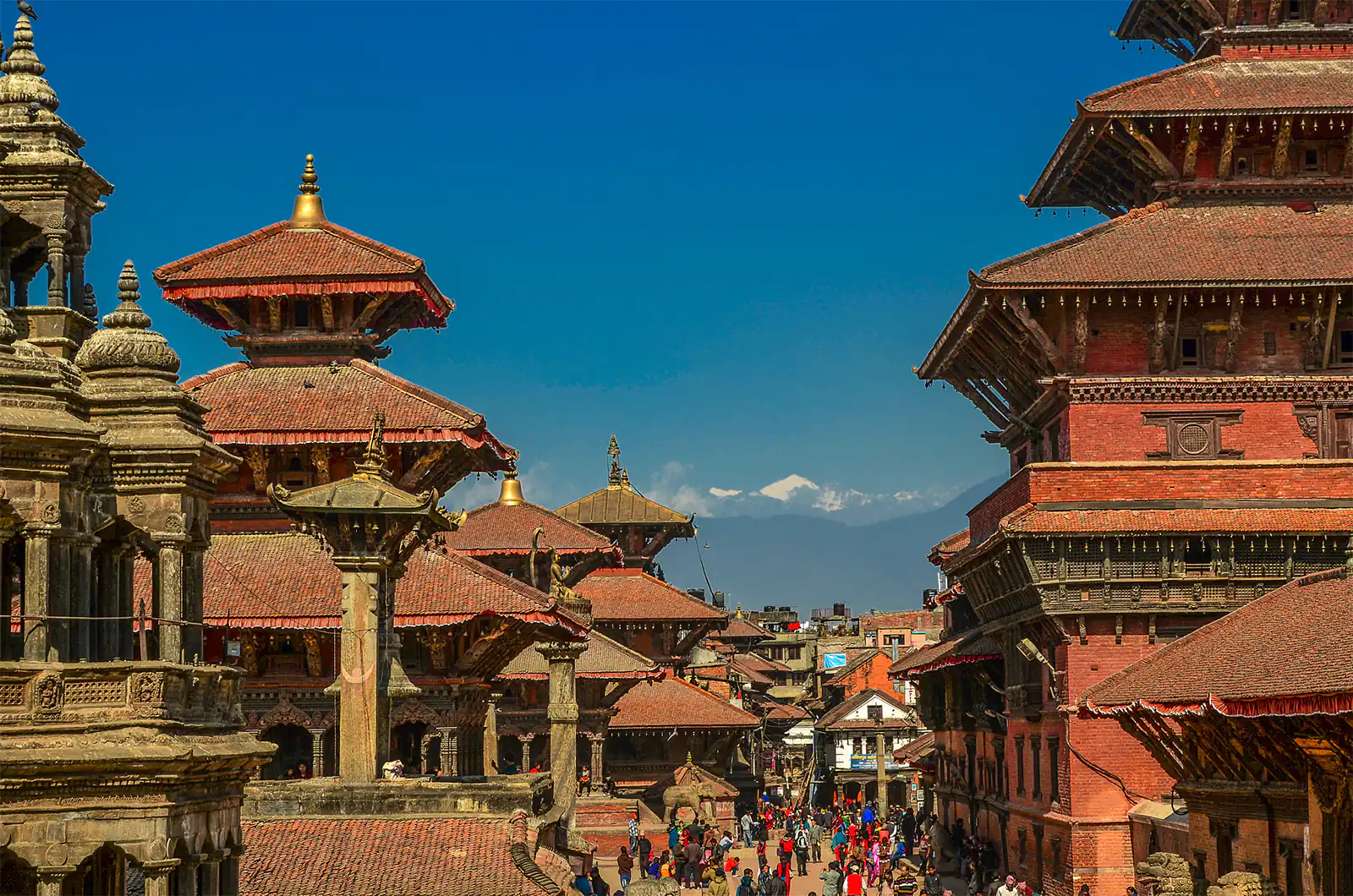
Best Time to Visit Patan Durbar Square
A warm and temperate climate characterizes Patan. The hottest months are June and July, accompanied by heavy rains. You can come to Patan any time of the year, the peak season being May, June, and September.
But of course, you are not in Nepal only to visit Patan, so the preferable time to visit Nepal is from March to early June and from September to early December.
How to get to Patan Durbar Square?
Patan Durbar Square is just 4 km from Kathmandu, separated by the Bagmati river. Remember that Patan Durbar square is a no-vehicle zone, so any transport mode you choose leaves you next to the white arc of Patan Dhoka. From there, you have to follow the widest street through the perpendicular alleys to the right; you will see the high roofs of the Patan Durbar Square temples.
You can easily visit Patan Durbar square by:
Taxi: A taxi can leave you next to the white arc of Patan Dhoka in 15 minutes. The cost depends on your negotiation skills, but the taxi fare can be around NPR 500 to 600.
Public Bus: Regular buses and microbuses pass from Kathmandu to Patan and vice versa. You can take a bus from Kantipath or Ratna Park that will take you straight to Patan Dhoka. The bus fare is NPR 40-50, but this mode of transportation will be challenging for you, especially during office hours from 9 am to 5 pm.
Walk: Walking will be the wisest route if you are up for some sightseeing in Kathmandu and Patan. However, the road can be dusty and crowdy. So try to take a day trip to Patan on foot during weekends when there is less traffic.
Entrance Fee to Patan Durbar Square
You have to pay NPR 1000 per person to enter Patan Durbar Square. If you are SAARC nation national, the entry fare is NPR 250 and NPR 30 for Nepalese. The money collected is used for the conservation and preservation of the area with the upliftment of people’s economy.
Attractions
Patan Durbar Square used to be the holy abode of Patan Kings. Today, it has become a mystical confluence of palace buildings, picturesque courtyards, and graceful pagodas. It represents the beautiful examples of Newar art and culture that reached its peak during the reign of the Malla and Licchavi kings.
Here are the major attractions of Patan Durbar Square:
Royal Palace
The royal palace is rightfully situated in the center of the durbar complex. Different parts of the palace buildings appeared in the 14th century, while its central part was completed later, in the 17th-18th centuries.
The palace was constructed during the reign of Siddhinarsingh Malla, Srinivas Malla, and Vishnu Malla. However, most architecture was destroyed when king Prithvi Narayan Shah attacked the city. During the 1934 earthquake, most of the significant architectural buildings were destroyed. But it still stood as the brightest architectural masterpiece of the valley.
Keshav Narayan Chowk
The Golden Gate leads to the northern courtyard of the complex, built in 1734, above which rises a golden Torana depicting Shiva, Parvati, Ganesha, and Kumar. Above the Torana is a golden window from which, during important events, the King used to address the townspeople.
One restored part of Keshav Narayan Chowk houses the Patan Museum, which is popular with visitors. Its galleries contain collections of bronze and copper items, Hindu and Buddhist deities figurines, and much more.
Opposite Keshav Narayan Chowka is Manga Hiti (tap), a water source famous for its three impressive stone-carved heads of Makaras (mythical ocean creatures), from whose mouths water flows.

Mul Chowk
This complex’s central courtyard is the largest and primeval of the three main courtyards of the square (Keshav Narayan Chowka, Mul Chowka, and Sundari Chowka). Built by Siddhinarsingha Malla and damaged by fire in 1662, Srinivasa Malla restored the chowk in 1665.
It was restored in 1665-66 by Srinivasa Malla. Two stone lion figurines guard the entrance to the courtyard, and in its center stands a small gilded Bidya temple.
There are three palace temples around Mul Chowk: Chyasim Deval, Hari Shankar, and Degutale. The five-storied pagoda-styled temple Degutale, located on the northeast side of the square, is crowned with three octagonal roofs.
Taleju Temple, or Taleju Bhavan, built by Siddhinarsingha Malla in 1640, is located north of Mul Chowk. At its entrance are statues of the goddess Ganga sitting on a turtle and the goddess Yamuna on a crocodile.
Opposite Mul Chowk and north of the Krishna temple is a large bell held by chains of two mighty pillars. King Vishnu Malla installed it in 1736. Previously, there was another bell on this site; in 1703, it was moved to the Rato Mahendranath temple.
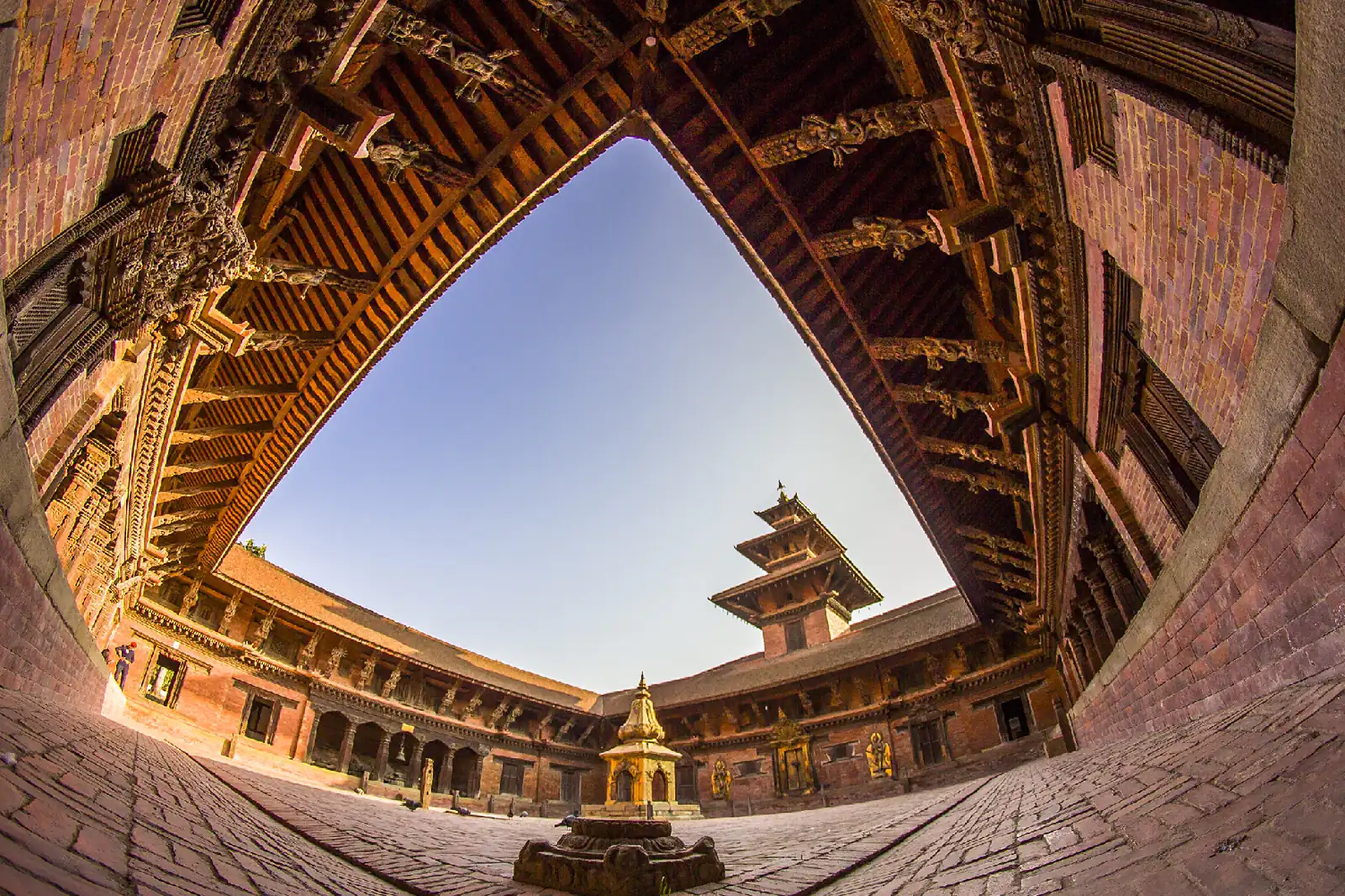
Sundari Chowk
To the south of Mul Chowk is the smallest courtyard of the complex – Sundari Chowk with its royal bath – Tusha Hiti. The walls of Tusha Hiti are decorated with elegant stone carvings and a fountain completely covered with figurines of deities carved from stone.
A pair of snakes at the top edge guards the approach to the stairs. Opposite Vishnu and his wife Lakshmi sit on Garuda.
Behind Sundari Chowk is the Royal Garden with a water reservoir – Kamal Pokhari. At the Sundari Chowk entrance are Hanuman, Narasingha, and Ganesha statues.
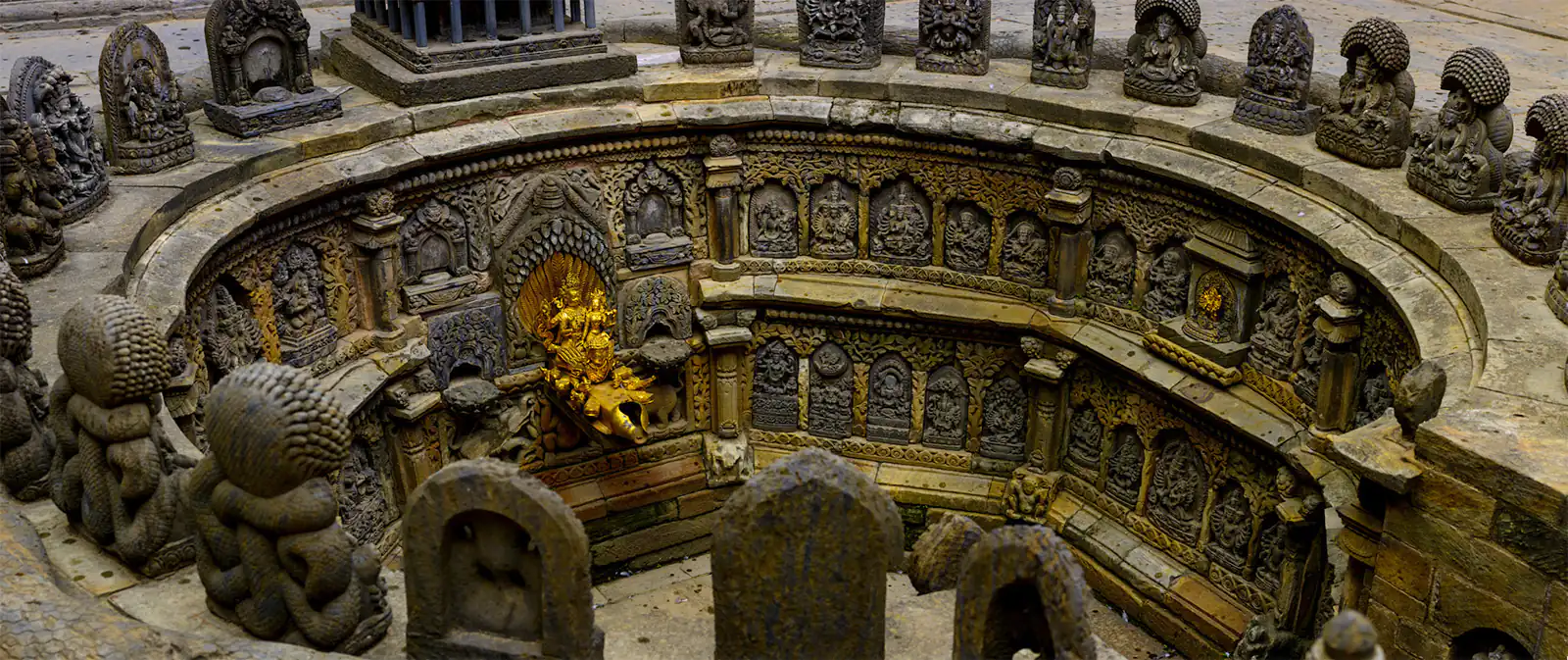
Rudra Varna Mahavira Temple
Rudra Varna Mahavira Temple, also known as Uku Bahal, lies a few steps from the Mahaboudha Temple. It contains magnificent images and statues in stone, metal, and wood. A paved courtyard surrounds the two-story building with a gilded roof. It is believed that in former times kings were crowned here.
It is densely crowded with statues of deities, figures of animals, and Buddhist attributes – Dorje (vajra), ceremonial bells, and so on. The Rudra Varna Mahavir dates back to the era of 19th century. But there is an assumption that it is one of the oldest monasteries in the valley, founded during the rule of the Licchavis in the 5th-6th centuries.
Golden Temple/ Kwa Bahal
This unique Buddhist monastery is known to the public as Hiranya Varna or Suvarna Mahavira. It is located north side of Durbar Square. According to legend, it was constructed in the 12th century, although the first mention of its extant dates back to 1409.
Kwa Bahal is a large rectangular building with three roofs and a copper-gold facade. In the altar room (photo and video filming are prohibited), there is a beautiful statue of Shakyamuni Buddha. On the far right side of the durbar square courtyard, you can see the statue of Vajrasattva, dressed in a silver and gold robe.
In the courtyard’s center stands a small, richly adorned temple with a golden roof, its shape resembling a bell (gajur). Inside the old temple is a small stupa (chaitya), according to the monks – self-manifested. In the four courtyard corners are figures of four Lokeshvaras and four monkeys in the southern part – the deity of Tara.
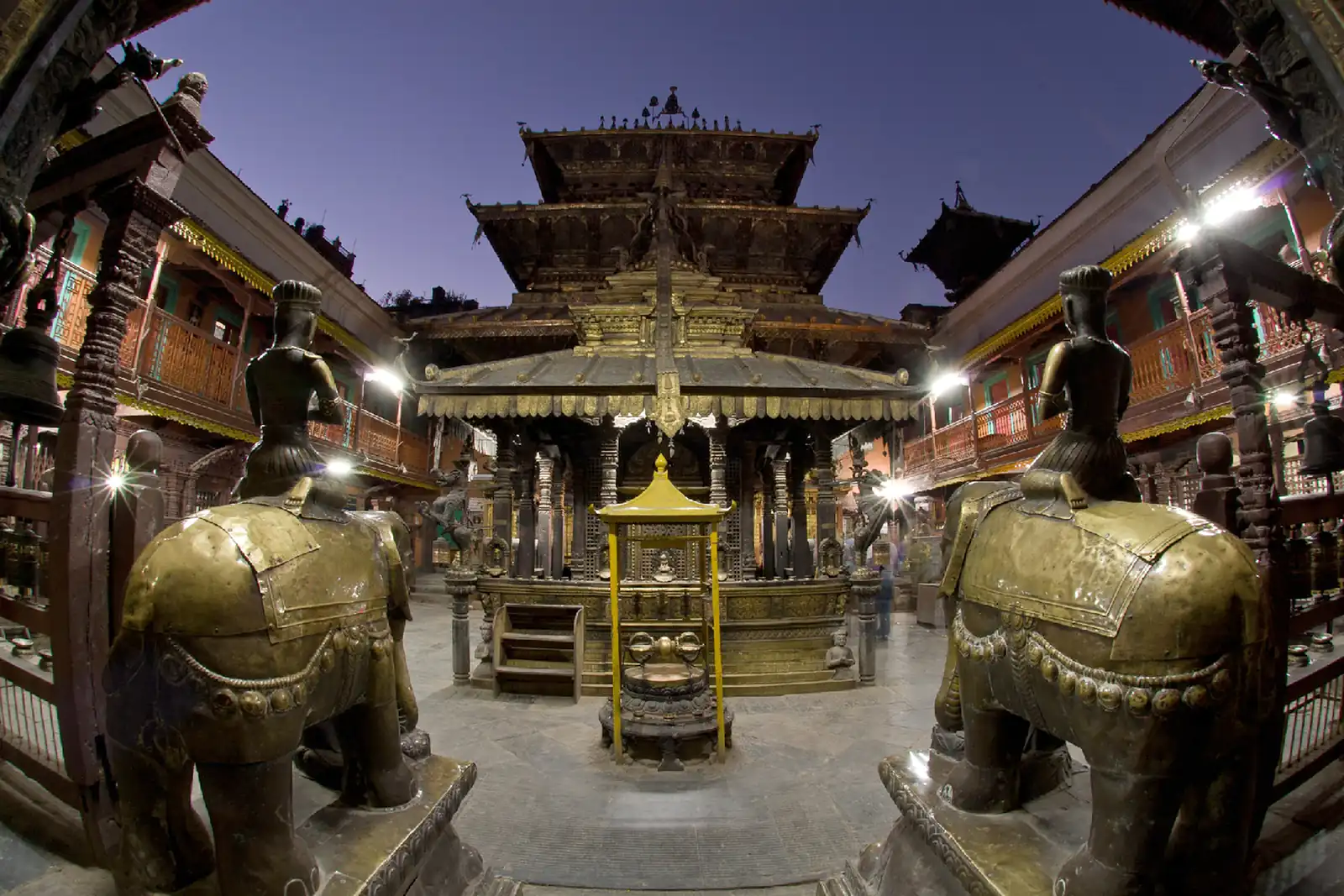
Bhimsen Temple
Bhimsen temple is positioned on the north side of Patan durbar square. It is a temple dedicated to Bhim – one of the Pandava brothers, the hero of the Mahabharata.
Vishwanath (Shiva) Temple
Opposite the Bhimasen temple is the recently restored, elaborately decorated, dedicated to the Holder of the Trident Vishwanath Temple, built in 1627. At its entrance are two prominent stone figures of elephants – the protectors of the sanctuary, and next to them – a statue of the bull Nandi, the eternal companion of Mahadeva. As in many other places dedicated to Lord Shiva, a large lingam is installed here.
Temple of Uma Maheshwar
To the north of the square stands a small inconspicuous temple-pagoda of Uma Maheshwar. In this temple, you can see a magnificent carved black stone deity of Shiva and Parvati, known as Uma Maheshwar. The deity statue depicts a seated cross-legged Shiva and his shakti (wife) seductively leaning against him.
Bishwakarma Temple
The southern border of the Patan durbar Square is dedicated to Bishwakarma. He is known as the gods’ architect and artisans’ patron. The facade of the temple is covered with embossed copper sheets. From the nearby workshops comes the rhythmic clatter of the hammers of working chasers.
Temple of Mahaboudha or Mahabuddha
To the east of Patan’s Durbar Square is the Mahaboudha Temple, an exquisite piece of Buddhist architecture. It is a copy of the temple in Bodhgaya, where Shakyamuni Buddha attained Enlightenment under the bodhi tree.
This architectural masterpiece was created in the 14th century. It can be seen that hundreds of Buddha images are engraved on the walls of the temple. So it is also known as the temple of thousands of Buddhas.
It is truly a masterpiece of Nepalese architecture, hidden behind the walls of the city buildings of Patan. Built-in the shikhara style, it is covered with terracotta tiles from the base to the dome, with a bas-relief of the Buddha on each of them.
Kumbheshwar Temple
Kumbheshwar Temple is one of the three temples of Kathmandu valley with five roofs. The temple was constructed in 1392, dominating the outskirt streets, and is the oldest in Patan. The building of the temple stands out with impressive proportions and elegant wood carvings.
In front of the temple is a bull Nandi statue, indicating that the temple is allocated to Lord Shiva. On the temple platform is two reservoirs, the waters of which, according to legend, are connected to the sacred lake Gosainkund, located far to the north of the valley. During the days of Janai Purnima in August, crowds of pilgrims flock here to take a bath.
Behind a black lacquered latticework, at the southeastern edge of the courtyard, is the significant Bhairav Temple, which worships the life-size wood carving of the deity Bhairav, the incarnation of Shiva. Next to it is the temple of Baglamukhi (Parvati).
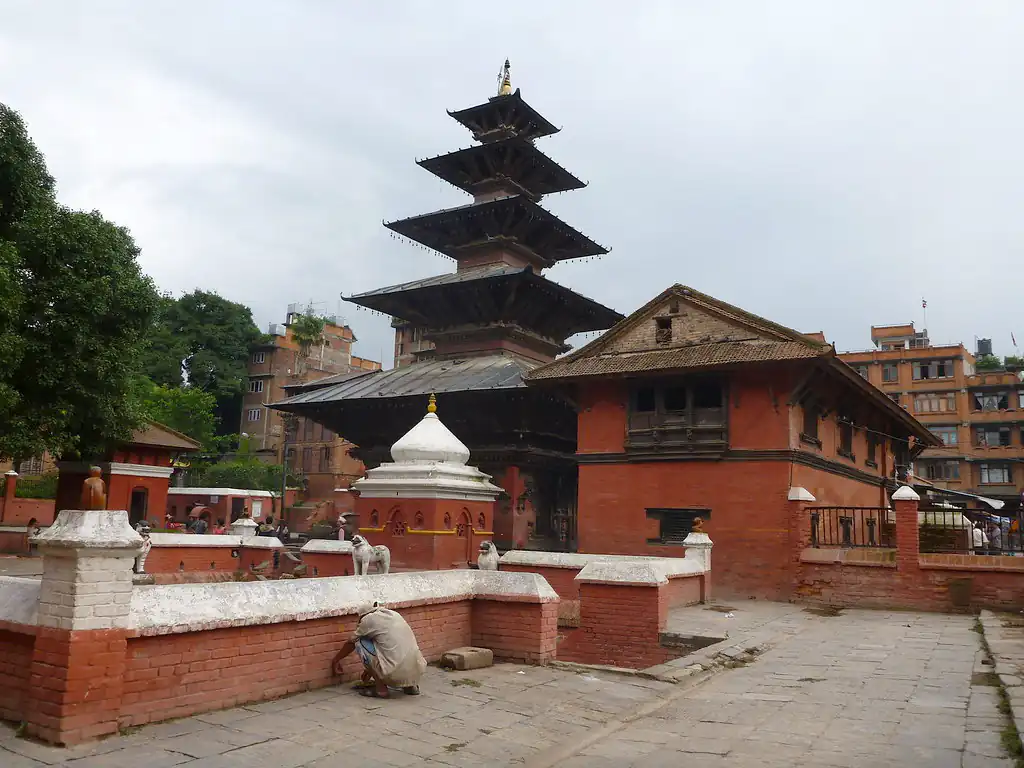
Temple of Rato (Red) Machindranath
The Temple of the Red Machindranath, built in 1673, is located southwest of Patan Durbar Square. Rato Machindranath is the deity of rain and abundance. Buddhists revere him as Avalokiteshvara; for Hindus, he is an avatar of Shiva.
Four lions guard four carved temple passages. Various animals: peacocks, horses, buffaloes, lions, elephants, and snakes rise on free-standing columns in front of the north side of the temple. The temple roof is supported by props, each depicting Avalokiteshvara standing over the figures of sinners subjected to various punishments in hell.
Jagat Narayan Temple
The Jagat Narayan Temple, devoted to Lord Vishnu, perches on the Bagmati River bank in Sankhamul. It is a two-level temple built in the pagoda style of red brick. It is considered the oldest on the square, dating back to 1565. The entry to the temple, standing on a three-stage brick plinth, is guarded by two stone lion figurines. The temple is known for the wooden carvings on the roof supports depicting various gods and erotic scenes.
Here is a Garuda metal statue, mounted on a stone megalith, surrounded by several images of Ganesha and Hanuman.
Ashok Stupas
Four stupas were built around Patan’s perimeter by Emperor Ashoka’s order in 250 BC- the heyday of Buddhism in the Kathmandu valley. The northern stupa is called Ibahi thura, the eastern one is called Teta Thura, the western stupa is known as Pucho Thura, and the southern stupa is called Laban Thura.
Tibetan Refugee Camp
The Tibetan refugee camp lies on the periphery of Patan are a popular tourist attraction. Many shops sell handmade wool carpets and handicrafts – wooden bowls, prayer wheels, and jewelry. The camp also consists of a stupa and several temples.
Krishna Mandir
It is the most impressive building in the Royal Complex area. Built entirely of Indian-style stone by King Siddhinarsingh Malla in 1637, this temple is strikingly different from neighboring Newar pagoda temples of red brick and wood. It is one of the main attractions of Patan Durbar Square.
The second and third floors, from which temple musicians often play the melodies, form a line of three miniature pavilions. At the top of each of them rises a spire in the style of a shikhara.
Krishna is the incarnation of the god Vishnu; for this reason, in front of the temple, on top of the column, sits on his knees Garuda, the companion and faithful servant of Vishnu.
Stone carvings along the columns recount the events described in the Mahabharata and Ramayana, ancient sacred tales. Explanations in the Newari language accompany these beautiful friezes.
The Krishna Mandir is outstanding on the Krishna Janmashtami holiday – the birthday of Krishna, annually celebrated in Bhadra (August-September). Only Hindus are authorized to enter the temple.
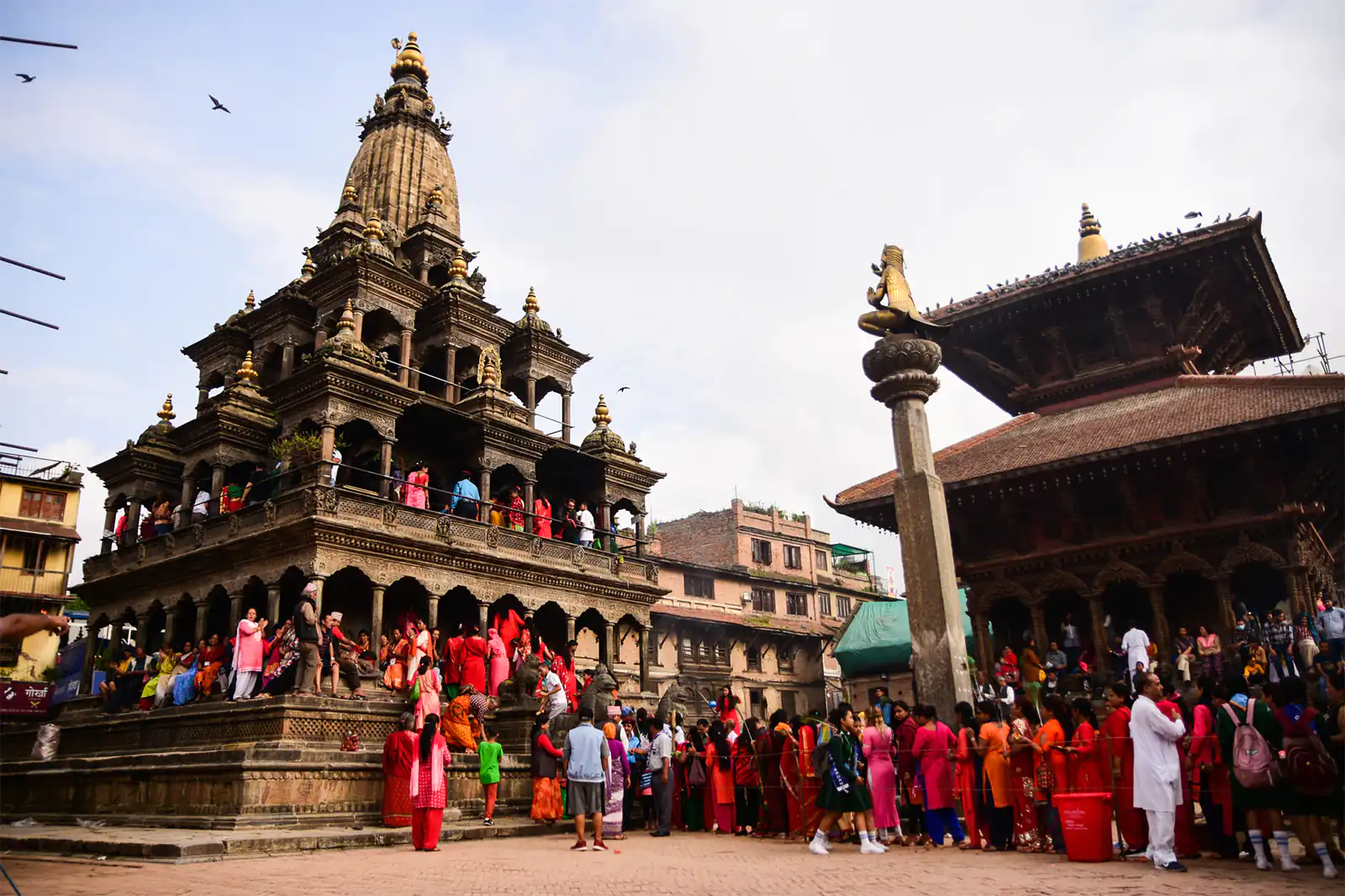
Patan Industrial Estate
It is located in Lagankhel nearby Patan Durbar Square, where handicrafts are practiced – wood carving, metalwork, handmade wool carpet production, and thangka painting. There are shopping arcades where you can buy any goods manufactured here.
Column of King Yoganarendra Malla
Opposite the entrance to the royal palace stands a high tetrahedral column erected in 1700, the column of Yoganarendra Malla. The column top is decorated with the King’s statue sitting on a lotus with his wife and daughter.
The king cobra, a symbol of wisdom, protects the golden figure of the King, who bowed his knee and opened his hood. The head of the wife, sitting on the King’s left hand, is covered by Sheshnag (a many-headed snake) and is closely associated with Vishnu and his wife Lakshmi in the Puranas.
On the head of the king cobra is a figure of a small bird whose role needs to be clarified. However, according to the legend, while the bird is there, the King is always a welcome guest in the palace. Therefore, in anticipation of the King’s return, the doors and windows of the palace always remain open.
